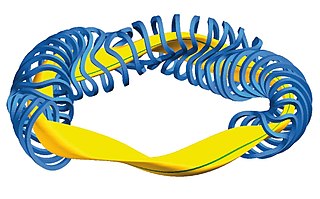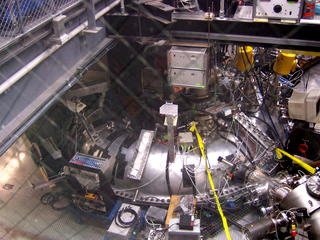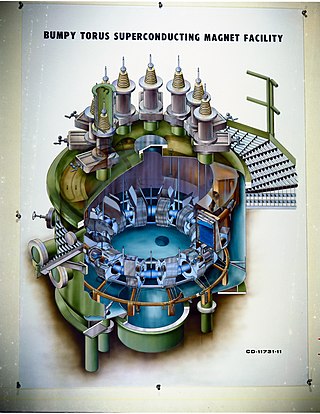Due to the presence of charged particles in plasma, plasma diffusion significantly differs from diffusion of gas or liquid. Even in the absence of externally applied fields, the interaction between the positive (ions) and negative (usually, electrons) plasma particles results in ambipolar diffusion with the diffusion coefficient that is dissimilar to that of either electron or ion species separately if the interaction is neglected.
Plasma diffusion across a magnetic field is an important topic in magnetic confinement of fusion plasma. It especially concerns how plasma transport is related to the strength of an external magnetic field B. Classical diffusion predicts the 1/B2 scaling, while Bohm diffusion, borne out of experimental observations from early confinement machines, was conjectured to follow the 1/B scaling. It is still an area of active research.

A stellarator is a plasma device that relies primarily on external magnets to confine a plasma. Scientists researching magnetic confinement fusion aim to use stellarator devices as a vessel for nuclear fusion reactions. The name refers to the possibility of harnessing the power source of the stars, such as the Sun. It is one of the earliest fusion power devices, along with the z-pinch and magnetic mirror.

A magnetic mirror, also known as a magnetic trap or sometimes as a pyrotron, is a type of magnetic confinement fusion device used in fusion power to trap high temperature plasma using magnetic fields. The mirror was one of the earliest major approaches to fusion power, along with the stellarator and z-pinch machines.

Magnetohydrodynamics is a model of electrically conducting fluids that treats all interpenetrating particle species together as a single continuous medium. It is primarily concerned with the low-frequency, large-scale, magnetic behavior in plasmas and liquid metals and has applications in numerous fields including geophysics, astrophysics, and engineering.

A fusor is a device that uses an electric field to heat ions to a temperature in which they undergo nuclear fusion. The machine induces a potential difference between two metal cages, inside a vacuum. Positive ions fall down this voltage drop, building up speed. If they collide in the center, they can fuse. This is one kind of an inertial electrostatic confinement device – a branch of fusion research.

Inertial electrostatic confinement, or IEC, is a class of fusion power devices that use electric fields to confine the plasma rather than the more common approach using magnetic fields found in magnetic confinement fusion (MCF) designs. Most IEC devices directly accelerate their fuel to fusion conditions, thereby avoiding energy losses seen during the longer heating stages of MCF devices. In theory, this makes them more suitable for using alternative aneutronic fusion fuels, which offer a number of major practical benefits and makes IEC devices one of the more widely studied approaches to fusion.

Magnetic reconnection is a physical process occurring in electrically conducting plasmas, in which the magnetic topology is rearranged and magnetic energy is converted to kinetic energy, thermal energy, and particle acceleration. Magnetic reconnection involves plasma flows at a substantial fraction of the Alfvén wave speed, which is the fundamental speed for mechanical information flow in a magnetized plasma.

Aneutronic fusion is any form of fusion power in which very little of the energy released is carried by neutrons. While the lowest-threshold nuclear fusion reactions release up to 80% of their energy in the form of neutrons, aneutronic reactions release energy in the form of charged particles, typically protons or alpha particles. Successful aneutronic fusion would greatly reduce problems associated with neutron radiation such as damaging ionizing radiation, neutron activation, reactor maintenance, and requirements for biological shielding, remote handling and safety.
Ambipolar diffusion is diffusion of positive and negative species with opposite electrical charge due to their interaction via an electric field. In the case of ionic crystals, the fluxes of the diffusing species are coupled, while in a plasma the various species diffuse at the same rate.

The Madison Symmetric Torus (MST) is a reversed field pinch (RFP) physics experiment with applications to both fusion energy research and astrophysical plasmas.
The diffusion of plasma across a magnetic field was conjectured to follow the Bohm diffusion scaling as indicated from the early plasma experiments of very lossy machines. This predicted that the rate of diffusion was linear with temperature and inversely linear with the strength of the confining magnetic field.
A dusty plasma is a plasma containing micrometer (10−6) to nanometer (10−9) sized particles suspended in it. Dust particles are charged and the plasma and particles behave as a plasma. Dust particles may form larger particles resulting in "grain plasmas". Due to the additional complexity of studying plasmas with charged dust particles, dusty plasmas are also known as complex plasmas.
Neutral-beam injection (NBI) is one method used to heat plasma inside a fusion device consisting in a beam of high-energy neutral particles that can enter the magnetic confinement field. When these neutral particles are ionized by collision with the plasma particles, they are kept in the plasma by the confining magnetic field and can transfer most of their energy by further collisions with the plasma. By tangential injection in the torus, neutral beams also provide momentum to the plasma and current drive, one essential feature for long pulses of burning plasmas. Neutral-beam injection is a flexible and reliable technique, which has been the main heating system on a large variety of fusion devices. To date, all NBI systems were based on positive precursor ion beams. In the 1990s there has been impressive progress in negative ion sources and accelerators with the construction of multi-megawatt negative-ion-based NBI systems at LHD (H0, 180 keV) and JT-60U (D0, 500 keV). The NBI designed for ITER is a substantial challenge (D0, 1 MeV, 40 A) and a prototype is being constructed to optimize its performance in view of the ITER future operations. Other ways to heat plasma for nuclear fusion include RF heating, electron cyclotron resonance heating (ECRH), ion cyclotron resonance heating (ICRH), and lower hybrid resonance heating (LH).
Migma, sometimes migmatron or migmacell, was a proposed colliding beam fusion reactor designed by Bogdan Maglich in 1969. Migma uses self-intersecting beams of ions from small particle accelerators to force the ions to fuse. Similar systems using larger collections of particles, up to microscopic dust sized, were referred to as "macrons". Migma was an area of some research in the 1970s and early 1980s, but lack of funding precluded further development.
The polywell is a design for a fusion reactor based on two ideas: heating ions by concentrating (-) charge to accelerate the ions and trapping a diamagnetic plasma inside a cusp field.

The Helically Symmetric Experiment, is an experimental plasma confinement device at the University of Wisconsin–Madison, with design principles that are intended to be incorporated into a fusion reactor. The HSX is a modular coil stellarator which is a toroid-shaped pressure vessel with external electromagnets which generate a magnetic field for the purpose of containing a plasma. It began operation in 1999.

Plasma is one of four fundamental states of matter, characterized by the presence of a significant portion of charged particles in any combination of ions or electrons. It is the most abundant form of ordinary matter in the universe, mostly in stars, but also dominating the rarefied intracluster medium and intergalactic medium. Plasma can be artificially generated, for example, by heating a neutral gas or subjecting it to a strong electromagnetic field.

The bumpy torus is a class of magnetic fusion energy devices that consist of a series of magnetic mirrors connected end-to-end to form a closed torus. It is based on a discovery made by a team headed by Ray Dandl at Oak Ridge National Laboratory in the 1960s.
In physics a non-neutral plasma is a plasma whose net charge creates an electric field large enough to play an important or even dominant role in the plasma dynamics. The simplest non-neutral plasmas are plasmas consisting of a single charge species. Examples of single species non-neutral plasmas that have been created in laboratory experiments are plasmas consisting entirely of electrons, pure ion plasmas, positron plasmas, and antiproton plasmas.
Classical diffusion is a key concept in fusion power and other fields where a plasma is confined by a magnetic field within a vessel. It considers collisions between ions in the plasma that causes the particles to move to different paths and eventually leave the confinement volume and strike the sides of the vessel.

The Penning–Malmberg trap, named after Frans Penning and John Malmberg, is an electromagnetic device used to confine large numbers of charged particles of a single sign of charge. Much interest in Penning–Malmberg (PM) traps arises from the fact that if the density of particles is large and the temperature is low, the gas will become a single-component plasma. While confinement of electrically neutral plasmas is generally difficult, single-species plasmas can be confined for long times in PM traps. They are the method of choice to study a variety of plasma phenomena. They are also widely used to confine antiparticles such as positrons and antiprotons for use in studies of the properties of antimatter and interactions of antiparticles with matter.